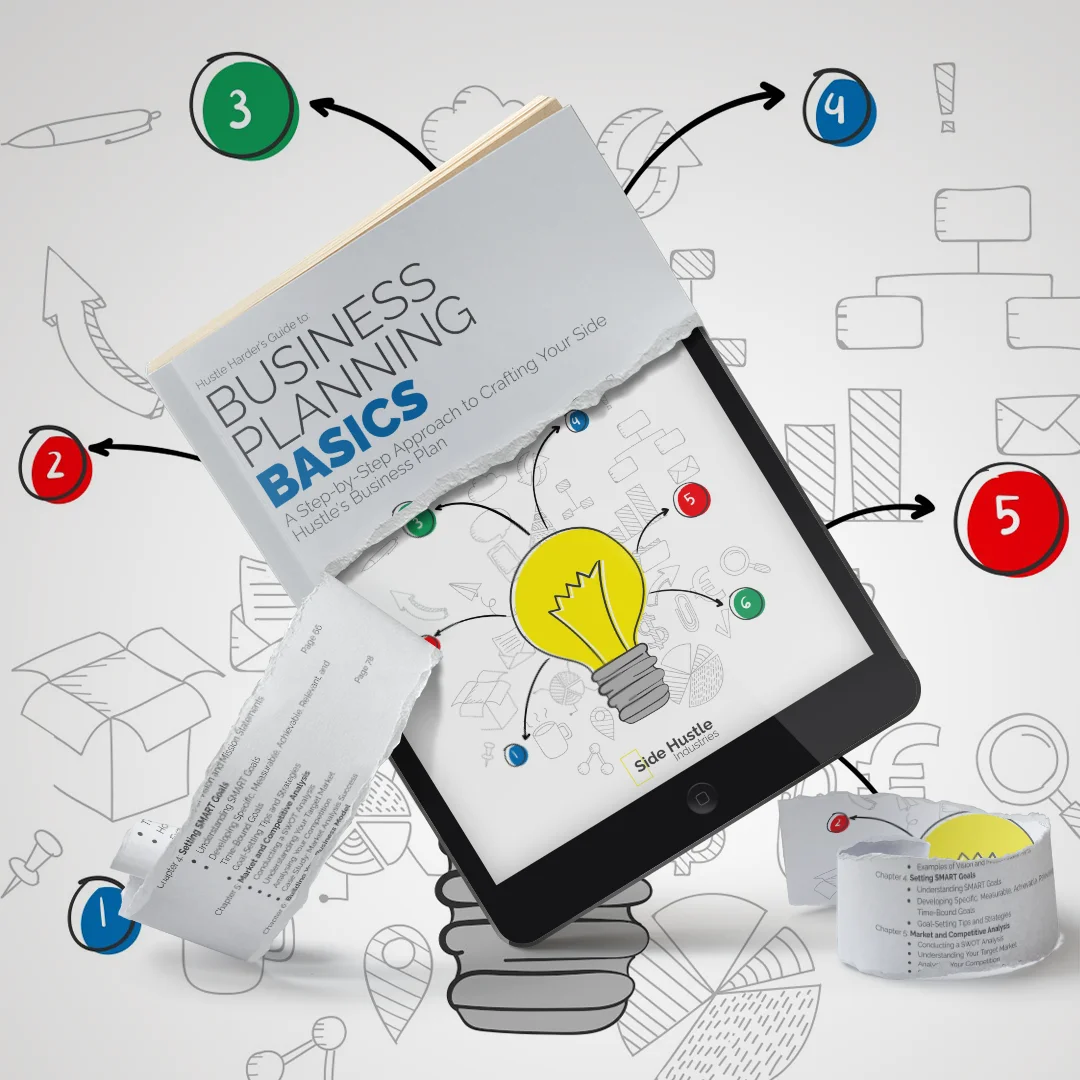
In the thrilling world of entrepreneurship, setting clear and well-defined goals is the compass that guides your journey. Goals give your entrepreneurial venture a sense of direction, purpose, and a roadmap to follow. Without them, you might find yourself wandering aimlessly, struggling to make progress, or even losing sight of why you started your side hustle in the first place. Today , we will delve into the crucial task of defining your entrepreneurial goals and how to do it effectively.
The Power of Clear Goals
Imagine embarking on a cross-country road trip without a map or a destination in mind. You’re driving, but you have no idea where you’re going, why you’re going there, or what you hope to achieve. It’s an unsettling thought, right? The same principle applies to your entrepreneurial journey. Without well-defined goals, you risk wandering without a clear sense of purpose or achievement.
Clear goals offer a multitude of benefits:
- Direction: Goals provide a clear path forward, outlining where you want your side hustle to go.
- Motivation: They serve as a source of motivation, pushing you to work towards something meaningful.
- Measurement: Goals create a basis for measurement and evaluation, allowing you to track your progress and assess your success.
- Focus: They help you prioritise tasks and allocate resources more effectively.
- Accountability: Setting goals makes you accountable to yourself, your team, or any stakeholders involved.
- Clarity: Having clear goals allows you to communicate your vision and objectives to others effectively.
Now that you understand the power of clear goals, let’s explore how to define them for your entrepreneurial endeavour.
The SMART Goal Framework
Effective goal-setting is all about making your objectives Specific, Measurable, Achievable, Relevant, and Time-bound—commonly referred to as SMART goals. This framework ensures that your goals are not vague, unattainable, or lacking a clear timeframe. Let’s break down each element of the SMART framework:
Specific
Specific goals are clear and unambiguous. They answer the question of “what” you want to achieve. Specific goals provide a roadmap that leaves no room for misinterpretation.
For example, instead of setting a vague goal like “Increase sales,” a specific goal might be “Increase monthly sales by 20% in the next six months by targeting new customer segments and launching a marketing campaign.”
Measurable
Measurable goals are quantifiable and allow you to track progress. They answer the question of “how much” or “how many” and provide concrete criteria for success.
In the example above, the goal is measurable because it includes a specific percentage increase in sales over a defined timeframe. This allows you to assess whether you’ve achieved the goal or not.
Achievable
Achievable goals are realistic and attainable with the resources and constraints you have. They answer the question of “how” and ensure that your goals are within reach.
While setting challenging goals is encouraged, they should still be achievable based on your current situation. Setting unrealistic goals can lead to frustration and disappointment.
Relevant
Relevant goals are aligned with your overall vision and mission. They answer the question of “why” the goal matters and how it fits into your bigger picture.
For instance, your goal of increasing sales should be relevant to your business’s growth strategy and the needs of your target audience. It should contribute to the fulfilment of your long-term vision.
Time-bound
Time-bound goals have a specific timeframe or deadline attached to them. They answer the question of “when” the goal should be achieved, creating a sense of urgency and accountability.
Using the example, “Increase monthly sales by 20% in the next six months,” the goal is time-bound because it specifies a deadline within which the increase should occur.
By applying the SMART framework, you can transform abstract ideas into clear, actionable goals. Let’s take a closer look at how to define SMART goals for your entrepreneurial journey.

Steps to Define SMART Entrepreneurial Goals
Start with Your Vision: Begin by revisiting your side hustle’s vision and mission. Your goals should align with the broader purpose of your business. What are you ultimately striving to achieve, and how do your goals contribute to that vision?
Determine the “What”: Identify what specific achievements you want to attain. What do you want to improve, change, or create? These should be tangible and measurable outcomes.
Quantify and Set Metrics: Ensure your goals are measurable by attaching specific metrics or criteria to them. This might involve using numbers, percentages, timeframes, or any other quantifiable data that allows you to gauge progress.
Evaluate Achievability: Consider your available resources, such as time, money, and expertise. Are your goals realistically attainable given your current circumstances? If not, what steps can you take to make them more feasible?
Relate to Your Mission: Assess whether your goals are relevant to your mission and vision. Ask yourself how achieving these goals aligns with your long-term aspirations and values.
Establish Deadlines: Every goal should have a clear timeframe. Setting deadlines adds a sense of urgency and ensures that you’re held accountable for progress.
Now, let’s work through a practical example to illustrate the process of defining SMART entrepreneurial goals.
Practical Example: Launching a Handmade Jewellery Business
Imagine you’re passionate about creating handmade jewellery and want to turn it into a side hustle. Your vision is to share your unique designs with a broader audience. Let’s define some SMART goals for your jewellery business:
Vision Alignment: The overarching vision is to become a recognized handmade jewellery brand known for quality and uniqueness.
Specific Goals:
- Goal 1: Launch an e-commerce website within the next three months.
- Goal 2: Create and list 50 unique jewellery pieces for sale within the first six months.
- Goal 3: Achieve 100 online sales within the first year.
Measurable Metrics:
- Goal 1: The launch of an e-commerce website by a specified date.
- Goal 2: The creation and listing of 50 unique jewellery pieces on the website.
- Goal 3: Reaching 100 confirmed online sales.
Achievability: Given available resources, you decide that these goals are realistic. You have the skills to create the jewellery, access to e-commerce platforms, and the time to set up the website.
Relevance to Vision: All three goals align with your vision of becoming a recognized jewellery brand.
Timeframes: Each goal has a clear timeframe: three months for the website launch, six months for creating and listing jewellery, and one year for achieving 100 sales.
By following these steps and applying the SMART framework, you’ve defined clear, actionable goals for your handmade jewellery business. These goals will serve as your guiding light throughout your entrepreneurial journey.
Short-Term and Long-Term Goals
In entrepreneurship, it’s essential to differentiate between short-term and long-term goals. Short-term goals typically cover a period of less than one year and are focused on immediate tasks and achievements. Long-term goals, on the other hand, extend over multiple years and encompass your bigger vision and overarching objectives.
Short-term goals are the stepping stones that lead you toward your long-term vision. They break down the larger mission into manageable, actionable tasks. For instance, if your long-term goal is to become a recognized jewellery brand, a short-term goal might be to launch your website, create a specific number of jewellery pieces, or secure your first online sale.
Long-term goals provide direction and context for your short-term goals. They represent the milestones you aspire to reach over a more extended period. These goals help you maintain focus on your bigger picture while addressing the day-to-day tasks required to achieve it.
It’s crucial to strike a balance between short-term and long-term goals. While short-term goals drive immediate progress and keep you motivated, long-term goals keep you anchored to your mission and purpose, ensuring that you’re building a business that fulfils your vision.
Categories of Entrepreneurial Goals
Entrepreneurial goals can be categorised into several key areas, each of which plays a vital role in your business’s growth and development. Here are some common categories of entrepreneurial goals:
1. Financial Goals:
- Increasing revenue and profitability.
- Achieving a specific sales target.
- Reducing costs and expenses.
- Attaining a certain level of financial stability.
2. Customer and Market Goals:
- Expanding your customer base.
- Improving customer satisfaction and loyalty.
- Entering new markets or segments.
- Conducting market research and analysis.
3. Product and Service Goals:
- Launching new products or services.
- Improving product quality.
- Enhancing service offerings.
- Innovating and staying competitive.
4. Operational Efficiency Goals:
- Streamlining business processes.
- Reducing waste and inefficiency.
- Enhancing supply chain management.
- Automating repetitive tasks.
5. Marketing and Branding Goals:
- Building brand recognition and awareness.
- Increasing your online presence.
- Expanding your social media reach.
- Creating compelling marketing campaigns.
6. Team and Human Resource Goals:
- Hiring and retaining top talent.
- Providing ongoing training and development.
- Fostering a positive work environment.
- Reducing turnover and improving productivity.
7. Social and Environmental Responsibility Goals:
- Implementing sustainable practices.
- Giving back to the community.
- Reducing the environmental impact of your business.
- Supporting social causes and charities.
8. Personal and Work-Life Balance Goals:
- Maintaining a healthy work-life balance.
- Managing stress and achieving personal well-being.
- Setting boundaries between work and personal life.
- Ensuring personal growth and development.
It’s essential to strike a balance between these categories and set goals that address various aspects of your business and personal life. By doing so, you ensure a holistic approach to entrepreneurship that leads to well-rounded success.

Prioritising and Sequencing Goals
Entrepreneurship often involves wearing multiple hats and managing a variety of tasks simultaneously. This can make it challenging to prioritise and sequence your goals effectively. To address this, consider the following strategies:
Urgency and Importance: Use the Eisenhower Matrix, which categorises tasks into four quadrants based on their urgency and importance. Focus on the tasks that are both urgent and important, then tackle those that are important but less urgent. Defer or delegate tasks that are neither urgent nor important.
Short-Term and Long-Term: Prioritise short-term goals that have a direct impact on your long-term vision. These can serve as immediate wins and progress markers.
Resource Availability: Consider the resources you have available, such as time, budget, and manpower. Focus on goals that align with your current resource capacity.
Skill and Knowledge Development: Prioritise goals that contribute to your personal and professional development, as these can enhance your ability to achieve other goals.
Alignment with Values: Assess whether your goals align with your personal and business values. Pursuing goals that reflect your values can lead to a more fulfilling journey.
Feedback and Data: Regularly review your progress and gather feedback. Adjust your goals based on the insights you gain to ensure they remain relevant and achievable.
Remember that entrepreneurship is a dynamic journey, and your goals may need adjustment and refinement along the way. Be adaptable and open to change as circumstances evolve and new opportunities arise.
Setting “Stretch” Goals
While it’s crucial for your goals to be realistic and attainable, there’s also a place for what are known as “stretch” goals. These are ambitious objectives that push you beyond your comfort zone and challenge you to reach new heights. Stretch goals can be motivating and can lead to remarkable achievements.
For example, if your business typically experiences 10% growth each year, a stretch goal might be to achieve 25% growth within the next 12 months. Although it’s more challenging, reaching for this higher target can drive innovation, creativity, and an increased focus on efficiency.
Stretch goals, however, should be approached with caution. They should be balanced with a realistic understanding of your capabilities and available resources. Setting unattainable stretch goals can lead to burnout, frustration, or even failure. Striking the right balance between achievable and stretch goals is an art in entrepreneurship.

The Process of Goal Review and Adaptation
As your entrepreneurial journey progresses, it’s essential to regularly review and adapt your goals. This ensures that they remain relevant, aligned with your vision, and achievable based on changing circumstances. The process of goal review and adaptation involves the following steps:
Regular Review: Set aside time at regular intervals to assess your progress toward your goals. This could be weekly, monthly, or quarterly, depending on the nature of your goals.
Assessment: Evaluate whether you’ve made substantial progress, experienced setbacks, or if there have been any changes in your business or personal life that affect your goals.
Feedback Gathering: Gather feedback from team members, mentors, advisors, or customers. Their insights can provide valuable perspectives on your progress.
Adaptation: Based on your assessment and feedback, be open to adapting your goals. This may involve altering the time frame, modifying the scope, or even replacing a goal that no longer aligns with your vision.
Celebration: Don’t forget to celebrate your achievements, even if they’re incremental. Recognizing your progress can boost motivation and morale.
Recommitment: After adapting your goals, recommit to them with renewed determination. Use your review as a source of motivation to push forward.
The process of goal review and adaptation is a dynamic and ongoing one. It ensures that your goals remain relevant, that you stay aligned with your vision, and that you’re always striving for meaningful and achievable milestones.
Real-Life Example: Goal Review and Adaptation
Let’s revisit the practical example of launching a handmade jewellery business. After setting SMART goals, you’ve been diligently working toward your objectives. Here’s how goal review and adaptation might look:
Initial Goals:
Launch an e-commerce website within the next three months.
Create and list 50 unique jewellery pieces for sale within the first six months.
Achieve 100 online sales within the first year.
Review and Adaptation:
Goal 1: After two months, you’ve encountered unexpected challenges that have delayed your website launch. Based on your review, you adapt this goal by extending the deadline to four months. You also identify additional resources and support to overcome the challenges.
Goal 2: You’ve successfully created and listed 30 unique jewellery pieces within the first six months. However, based on customer feedback and market trends, you decide to adapt this goal by expanding your product range to 80 unique pieces within the first year.
Goal 3: At the end of the first year, you’ve achieved 85 online sales. While not hitting the initial target, you’re satisfied with the progress. You adapt this goal by extending it to 150 online sales within the next year, maintaining the commitment to growth.
Through this review and adaptation process, you ensure that your goals remain realistic, flexible, and aligned with your vision. This continuous assessment and adaptation can lead to better outcomes and a more agile approach to entrepreneurship.
Defining your entrepreneurial goals is the foundation of your business journey. SMART goals provide the clarity, focus, and motivation needed to move your side hustle forward. Remember to set both short-term and long-term goals, prioritise effectively, and be open to setting stretch goals when appropriate. Regularly review and adapt your goals to stay in line with your evolving vision and changing circumstances. With well-defined goals in place, you’re on your way to unlocking your full entrepreneurial potential and achieving remarkable success.

*Also available on Amazon in Kindle, Soft Cover & Hard Cover formats. —> Click Here.
